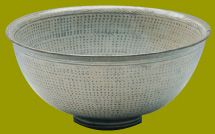


Karatsu ware with a long history manufactured following the techniques from the Chinese Continent
Tea masters especially must have greatly appreciated Karatsu ware saying that the first is Raku, the second, Hagi, and the third, Karatsu. Karatsu ware has been made all over the region from western Saga to Nagasaki. The name was given after the port of Karatsu from which its products were exported.
Karatsu is literally the port (tu) over to China (kara). Around the end of the Muromachi period potters came from China and Korea via Tsushima and Iki islands and began to fire glazed wares here. Semi-ground kilns of the stepped multi-chamber style appeared and took the place of the traditional anagama (single-chamber round kiln). Glazed wares using Korean techniques began to be fired at the base of Mt. Kishitake south of Karatsu City, and are called "Ko-Garatsu." The remains of seven Ko-Garatsu kilnsare still to be found.
In 1594 (Bunroku 3) outraged Hideyoshi Toyotomi destroyed the Hata, the lord of the domain, and consequently forced the potters out of the region. This is known as "the Kishitake collapse."

